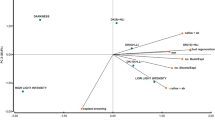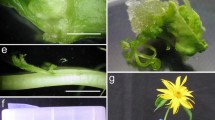Abstract
A new approach for shoot regeneration from split embryonic axes of Helianthus annuus var. RHA266, a poor responding genotype to in vitro culture, has been developed. The regeneration procedure is based on successive excision of the apical and axillary shoots originating from pre-existing meristems. This elimination process stimulates adventitious shoot bud formation in 80% of treated explants. Although newly induced buds were observed on hormone-free medium, higher rate of induction and bud development were obtained on medium containing 0.1 mg l−1 BA. All regenerated plants were phenotypically similar to seed-derived RHA 266 plants with no observed somaclonal variation, as assessed by AFLP analysis. The efficient shoot regeneration from newly formed meristematic cells should offer opportunities to genetically engineer economically important sunflower genotypes that have proven till now, to be recalcitrant towards other regeneration systems.
Similar content being viewed by others
References
Bronner R, Jeannin G & Hahne G (1994) Early cellular events during organogenesis and somatic embryogenesis induced on immature zygotic embryos of sunflower (Helianthus annuus). Can. J. Bot. 72: 239-248
Burrus M, Chanabe C, Alibert G & Bidney D (1991) Regeneration of fertile plants from protoplasts of sunflower (Helianthus an-nuus L.). Plant Cell Rep. 10: 161-166
Charriere F & Hahne G (1998) Induction of embryogenesis versus caulogenesis on in vitro cultured sunflower (Helianthus annuus L.) immature zygotic embryos: role of plant growth regulators. Plant Sci. 137: 63-71
Charriere F, Sotta B, Miginiac E & Hahne G (1999) Induction of adventitious shoots or somatic embryos on in vitro cultured zygotic embryos of Helianthus annuus: variation of endogenous hormone levels. Plant Physiol. Biochem. 37:751-757
Encheva J, Ivanov P, Tsvetkova F & Nikolova V (1993) Develop-ment of a new initial breeding material in sunflower (Helianthus annuus L.) using direct organogenesis and somatic embryogenesis. Euphytica 68: 181-185
Espinasse A, Lay C & Volin J (1989) Effects of growth regulator concentrations and explant size on shoot organogenesis from callus derived from zygotic embryos of sunflower (Helianthus annuus L.). Plant Cell Tiss. Org. Cult. 17: 171-181
Everett NP, Robinson KEP & Mascarenhas D (1987) Genetic engineering of sunflower (Helianthus annuus L.). Bio/ technol 5: 1201-1204
Flores Berrios E, Gentzbittel L, Kayyal H, Alibert G & Sarrafi A (2000) AFLP mapping of QTLs for in vitro organogenesis traits using recombinant inbred lines in sunflower (Helianthus annuus L.). Theor. Appl. Genet. 101: 1299-1306
Freyssinet M & Freyssinet G (1988) Fertile plant regeneration from sunflower (Helianthus annuus L.) immature embryos. Plant Sci. 56: 177-181
Fulton TM, Chunwongse J & Tanksley SD (1995) Microprep protocol for extraction of DNA from tomato and other herbace-ous plants. Plant Mol. Bio. Rep. 13: 207-209
Goto S, Thakur RC & Ishii K (1998) Determination of genetic stability in long-term micropropagated shoots of Pinus thunbergii Parl. using RAPD markers. Plant Cell Rep. 18: 193-197
Greco B, Tanzarella OA, Carrozzo G & Blanco A (1984) Callus induction and shoot regeneration in sunflower (Helianthus annuus L.). Plant Sci. Lett. 36: 73-77
Knittel N, Escandon AS & Hahne G (1991)Plant regeneration at high frequency from mature sunflower cotyledons. Plant Sci. 73: 219-226
Knittel N, Gruber V, Hahne G & Lenee P (1994) Transformation of sunflower (Helianthus annuus L.): a reliable protocol. Plant Cell Rep. 14: 81-86
Lucas O, Kallerhoff J & Alibert G (2000) Production of stable transgenic sunflower (Helianthus annuus L.) from wounded immature embryos by particle bombardment and co-cultivation with Agrobacterium tumefaciens. Mol. Breed. 6: 479-487
Malone-Schoneberg J, Scelonge CJ, Burrus M & Bidney DL (1994) Stable transformation of sunflower using Agrobacterium and split embryonic axis explants. Plant Sci. 103: 199-207
McCann AW, Cooley G & Van Dreser J (1988) A system for routine plantlet regeneration of sunflower (Helianthus annuus L.) from immature embryo-derived callus. Plant Cell Tiss. Org. Cult. 14: 103-110
Mϋller A, Iser M & Hess D (2001) Stable transformation of sunflower (Helianthus annuus L.) using a non-meristematic regeneration protocol and green fluorescent protein as a vital marker. Transgenic Res. 10: 435-444
Murashige T & Skoog F (1962) A revised medium for rapid growth and bioassays with tobacco tissue cultures. Physiol. Plant. 15: 473-497
Nestares G, Zorzoli R, Mroginski L & Picardi L (1998) Cytoenesis. plasmic effects on the regeneration ability of sunflower. Plant Breed. 117: 188-190
Paterson KE (1984) Shoot tip culture of Helianthus annuus - flowering and development of adventitious and multiple shoots. Am. J. Bot. 71: 925-931
Power CJ (1987) Organogenesis from Helianthus annuus inbreds and hybrids from the cotyledons of zygotic embryos. Am. J. Bot. 74: 497-503
Pugliesi C, Megale P, Cecconi F & Baroncelli S (1993a) Organogenesis and embryogenesis in Helianthus tuberosus and in the interspecific hybrid Helianthus annuusΧHelianthus tuberosus. Plant Cell Tiss. Org. Cult. 33: 187-193
Pugliesi C, Biasini MG, Fambrini M & Baroncelli S (1993b) Genetic transformation by Agrobacterium tumefaciens in the interspecific hybrid Helianthus annuusΧHelianthus tuberosus. Plant Sci. 93: 105-115
Punia MS & Bohorova NE (1992) Callus development and plant regeneration from different explants of six wild species of sunflower (Helianthus L.). Plant Sci. 87: 79-83
Roseland CR, Espinasse A & Grosz TJ (1991) Somaclonal variants of sunflower with modified coumarin expression under stress. Euphytica 54: 183-190
Tang W (2001) In vitro regeneration of loblolly pine and random amplified polymorphic DNA analyses of regenerated plantlets. Plant Cell Rep. 20: 163-168
Vear F, Gentzbittel L, Philippon J, Mouzayar S, Mestries E, Roeckel-Drevet P, Tourvieille de Labrouhe D & Nicolas P (1997) The genetics of resistance to five races of downy mildiou (Plasmopara hastedii) in sunflower (Helianthus annuus L.). Theor. Appl. Genet. 95: 584-589
Vendrame WA, Kochert G & Wetzstein HY (1999) AFLP analysis of variation in pecan somatic embryos. Plant Cell Rep. 18: 853-857
Watanabe A, Araki S, Kobari S, Sudo H, Tsuchida T, Uno T, Kosaka N, Shimomura K, Yamazaki M & Saito K (1998) In vitro propagation, restriction fragment length polymorphism, and random amplified polymorphic DNA analyses of Angelica plants. Plant Cell Rep. 18: 187-192
Author information
Authors and Affiliations
Corresponding author
Rights and permissions
About this article
Cite this article
Hewezi, T., Jardinaud, F., Alibert, G. et al. A new approach for efficient regeneration of a recalcitrant genotype of sunflower (Helianthus annuus) by organogenesis induction on split embryonic axes. Plant Cell, Tissue and Organ Culture 73, 81–86 (2003). https://doi.org/10.1023/A:1022689229547
Issue Date:
DOI: https://doi.org/10.1023/A:1022689229547




